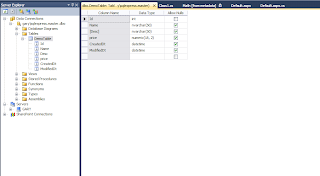Example in other languages:
public myClass()
{
private String someString;
public String getString()
{
return this.someString;
}
public void setString(String value)
{
this.someString = value;
}
}
you can do this in C#:
public myClass()
{
public String someString { get; set; }
}
That only explains how much it takes to write a Business Object class. Next we go to real work.
I created a simple demo project in VS 2010 (beta), you can use any visual studio to compile this if you want to try it out yourself.
in my Business object class:
using System;
using System.Collections.Generic;
using System.Linq;
using System.Text;
namespace DemoBizObject
{
public class BizObject
{
public int Id { get; set; }
public string Name { get; set; }
public string Desc { get; set; }
public decimal price { get; set; }
public DateTime CreatedDt { get; set; }
public DateTime ModifiedDt { get; set; }
}
}
in my aspx code behind, i did this:
using System;
using System.Collections.Generic;
using System.Linq;
using System.Web;
using System.Web.UI;
using System.Web.UI.WebControls;
using System.Collections.ObjectModel;
using DemoBizObject;
using System.Diagnostics;
using System.Web.UI.DataVisualization.Charting;
namespace DemoWebApp
{
public partial class _Default : System.Web.UI.Page
{
Collection<BizObject> BizObjects = new Collection<BizObject>();
double[] pocotimings = new double[7];
double[] typeddstimings = new double[7];
decimal d = 0.00m;
const int ONE = 1;
const int TEN = 10;
const int ONEHUNDRED = 100;
const int ONETHOUSAND = 1000;
const int TENTHOUSAND = 10000;
const int ONEHUNDREDTHOUSAND = 100000;
const int ONEMILLION = 1000000;
const string LINEBREAK = "<br />";
protected void Page_Load(object sender, EventArgs e)
{
}
protected void Button1_Click(object sender, EventArgs e)
{
this.Label1.Text += "Typed Datasets" + LINEBREAK + LINEBREAK;
this.Label1.Text += ONE +": "+ demoTypedDS(ONE)+ LINEBREAK;
this.Label1.Text += TEN + ": " + demoTypedDS(TEN) + LINEBREAK;
this.Label1.Text += ONEHUNDRED + ": " + demoTypedDS(ONEHUNDRED) + LINEBREAK;
this.Label1.Text += ONETHOUSAND + ": " + demoTypedDS(ONETHOUSAND) + LINEBREAK;
this.Label1.Text += TENTHOUSAND + ": " + demoTypedDS(TENTHOUSAND) + LINEBREAK;
this.Label1.Text += ONEHUNDREDTHOUSAND + ": " + demoTypedDS(ONEHUNDREDTHOUSAND) + LINEBREAK;
this.Label1.Text += ONEMILLION + ": " + demoTypedDS(ONEMILLION) + LINEBREAK + LINEBREAK;
this.Label1.Text += "POCO" + ": " + LINEBREAK + LINEBREAK;
this.Label1.Text += ONE + ": " + demoPOCO(ONE) + LINEBREAK;
this.Label1.Text += TEN + ": " + demoPOCO(TEN) + LINEBREAK;
this.Label1.Text += ONEHUNDRED + ": " + demoPOCO(ONEHUNDRED) + LINEBREAK;
this.Label1.Text += ONETHOUSAND + ": " + demoPOCO(ONETHOUSAND) + LINEBREAK;
this.Label1.Text += TENTHOUSAND + ": " + demoPOCO(TENTHOUSAND) + LINEBREAK;
this.Label1.Text += ONEHUNDREDTHOUSAND + ": " + demoPOCO(ONEHUNDREDTHOUSAND) + LINEBREAK;
this.Label1.Text += ONEMILLION + ": " + demoPOCO(ONEMILLION) + LINEBREAK + LINEBREAK;
}
private string demoTypedDS(int numOfRecords)
{
typedDS ds = new typedDS();
Stopwatch watch = Stopwatch.StartNew();
for (int i = 0; i < numOfRecords; i++)
{
ds.DemoTable.AddDemoTableRow(i, "demo name", "demo desc", d + i, DateTime.Now, DateTime.Now);
}
watch.Stop();
return watch.Elapsed.TotalSeconds.ToString();
}
private string demoPOCO(int numOfRecords)
{
BizObject tempObject;
Stopwatch watch = Stopwatch.StartNew();
for (int i = 0; i < numOfRecords; i++)
{
tempObject = new BizObject();
tempObject.Id = i;
tempObject.Name = "demo name";
tempObject.price = d + i;
tempObject.CreatedDt = DateTime.Now;
tempObject.ModifiedDt = DateTime.Now;
tempObject.Desc = "demo desc";
BizObjects.Add(tempObject);
}
watch.Stop();
return watch.Elapsed.TotalSeconds.ToString();
}
}
}
pardon my messy codes, i didn't want to create this project initially, but i want to be someone that talks the talk and walk the walk.Next, create a similar table in your database with following...
After that, right click on your solution file and click "Add new item" and select a dataset object.
Double click on the XSD file and go to your DB and drag-and-drop the table onto the XSD and you will get the table there..
The codes are very self explanatory and simple, not much re-using of codes especially @ the printing part.
I ran the test and get the results for POCO VS DS
Results are:
Typed Datasets
1: 4.1E-05
10: 5.47E-05
100: 0.0004515
1000: 0.0045912
10000: 0.0747852
100000: 0.6806366
1000000: 7.4931112
POCO:
1: 5.8E-06
10: 9.6E-06
100: 8.26E-05
1000: 0.0008128
10000: 0.0081756
100000: 0.1015654
1000000: 1.1922586
I tested it several times and dare to confirm that with this demo project, POCO is that Datasets in the lower range (1 to thousands) and the ratio justs exponential when the records reaches millions.
In this test, i only did instantiation and assignment, the Big O notation for:
- POCO = n Log n
- Dataset = C^n


Good test. It looks like you can roughly draw the line at 100,000 objects. My guess is only in specialized circumstances and perhaps more often in science fields, would you have to instantiate more than 100,000 objects at a time, or repetitively. But like I said, good test. It illustrates your point well.
ReplyDeleteI've had seen some application that requires parsing a couple of GB of CSV and it took 12 hrs to finish running.. it was written in perl, i've rewritten the parser in c# using linq n it finished in 25 mins.. Too bad I am not good with awk and sed.. Could be better in getting the job done.
ReplyDelete